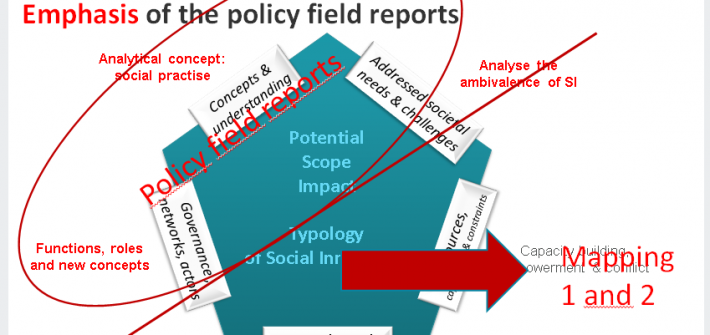SI-DRIVE published the “Compilation of the state of the art reports on the seven policy fields” by end of June. The report provides insights into the analysis of the key dimensions, elaborated in each of the seven policy fields, the practice fields identified in the different world regions and first observations concerning the relation between social innovation and social change. A “practice field” is a general type or “summary” of projects and expresses general characteristics common to different projects such as micro-credit systems and car sharing. In addition, the compilation report offers cases/examples implemented in the different practice fields that relate to societal challenges.
The cross-analysis of the seven policy field reports brought to light that the societal challenges that are addressed by social innovations often are cross-policy challenges. All policy field reports, in addition, notify an unclear understanding of the concept of social innovation, report on social innovations in their policy fields even if they are not called social innovations and call for further social innovations to respond to the societal challenges the world is facing. By analysing the policy field reports it is further observed that there is not always a linear relationship between cases, practice fields, societal challenges and policy fields. This is due to the fact that social innovation cases can belong to more than one practice field; cases can respond to more than one societal challenge; and cases can be grouped in more than one policy field. The multiple relations observed, however, are a clear sign for social innovations to grow in the area of societal challenges the regions are facing.
In addition, the societal and governance systems, in which the social innovations are embedded, are mostly characterised by a variety of organisations, actors and interests. Due to the different institutional factors, their varying actors, responsibilities and power structures and the diverse networks, the societal and governance systems of all seven policy fields are complex . The policy field’s governance systems are often centralised and hierarchically organised with the federal state as the main actor. Accordingly, also social change is often related to governance activities. But it is not only the governmental structures and its legislative/regulative environment at the various geographical scales (i.e. the international, national, the regional and the local level) that influences the existence and shape of social innovations, it is also the culture. Social innovations, thus, strongly depend on their context.
Next to the findings regarding the SI-Drive key dimensions, the following conclusions have been drawn in the compilation of the state of the art reports on the seven policy fields:
- The cross-analysis enlightened conflicting areas for social innovation. These mainly refer to tensions between policy objectives, between societal challenges, and between interests of actor groups as well as regions. At first sight it seems that it is a specific characteristic of social innovation to cross barriers of policy fields (including their objectives and challenges), of regions and of interest groups in order to respond to the manifold social needs. This is also confirmed by the policy field of education: “The ambivalence of innovations is reflected in the complicated and harmful innovation processes that bring together the different rationalities and cultures of the involved (educational) institutions and other actors. (…) Mainly, the strict (legal) boarders and the different responsibilities within the education system hinder the innovation process, and can be seen as the main barriers for new practices evolving from outside the system” (Policy field report on education, p.38);
- Any recommendations for policy makers so far derive from an analysis of the key research questions (i.e. the SI-Drive key dimensions). Given the strong need for social innovation highlighted by the various policy field experts, and, bearing in mind the drivers but in particular also the barriers for social innovation, a “social innovation friendly policy environment” still has to be developed in Europe as well as globally. A European (and global) Social Innovation Policy that enables for social innovations overcoming the societal challenges in a cooperative manner between the actor groups and that drives towards social change thus is regarded as a necessity.
The SI-DRIVE project aims at extending knowledge on social innovation (SI) in three major directions: 1) Integrating theories and research methodologies to advance understanding of SI leading to a comprehensive new paradigm of innovation; 2) Undertaking European and global mapping of SI, thereby addressing different social, economic, cultural, historical and religious contexts in eight major world regions; and 3) Ensuring relevance for policy makers and practitioners through in-depth analyses and case studies in seven policy fields, with cross European and world region comparisons, foresight and policy round tables. The seven policy field reports provide a practicable and fruitful source for future SI-Drive research related to these objectives. Nevertheless, the compilation of the state of the art report on policy fields has to be understood as a starting point that provides first insights from the policy field perspectives. In-depth answers to the key dimensions, incorporating also other perspectives such as those gained from the practice (i.e. from the mapping of social innovation cases), the policy makers (i.e. via the policy field fora) and the regions (i.e. from the regional reports), still have to follow.
What can be stated already, however, is that scientific research on social innovations, interactive communication with relevant networks of stakeholders and communities and the analysis of pertinent policy areas – as performed by the policy field examinations – have brought to light the strong need for social innovation in the seven policy fields. The findings of the state of the art reports on policy fields, in addition, indicate that “social innovation friendly policy environments” still have to be built in Europe as well as globally.

One thought on “Compilation of the state of the art reports on the seven SI-DRIVE policy fields”
Comments are closed.